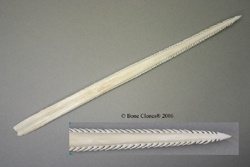Zoology: Bones
Sting Ray Tail Spine
Dasyatis sabina
Stingray Tail Spine
The stingray is mostly docile, very rarely inflicting serious injuries on humans. When profoundly disturbed, it will swing its tail with enough force to pierce flesh and, at the same time, release poison. Functioning much like a fish hook, the tail's many barbs keep the spine in place while the poison flows into the wound.
Stingray spines are composed of tissue called placoid scales. Placoid scales are similar in composition to teeth, with a blood-supplied pulp cavity and an exterior layer of dentine. Unlike cartilage, which comprises most of the skeleton, this tissue does not break down over time.
8 ½" / 21.6 cm Long
The original of this specimen is from Thailand.
Stingray spines are composed of tissue called placoid scales. Placoid scales are similar in composition to teeth, with a blood-supplied pulp cavity and an exterior layer of dentine. Unlike cartilage, which comprises most of the skeleton, this tissue does not break down over time.
8 ½" / 21.6 cm Long
The original of this specimen is from Thailand.




Manufacturer:
| Bone Clones |  |
All prices plus VAT and shipping costs

